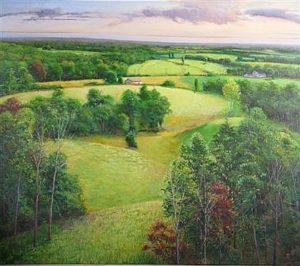Artists have been chronicling the changing American landscape for several hundred years. Early Hudson River School painters such as Thomas Cole were as fascinated with the rugged North American wilderness as with the efforts of settlers and farmers to tame it. George Inness, noting the way industry was transforming countryside, inserted tiny smoking locomotives into otherwise pastoral vistas.
Today, Inness’ single railroad track has given way to 16-lane highways, gigantic industrial developments, malls, and so on. In some places – stretches of the New Jersey Turnpike, for example – industrialization is so entrenched it no longer seems like an intrusion so much as a visual phenomenon in its own right.

“Industrial Landscape” by Peter Homitzky.
Peter Homitzky is a Hoboken artist who has spent much of the past 30 years painting the Meadowlands and the surrounding industrial scenes. He brings to these subjects the same devotion that Monet lavished on his haystacks and Cézanne on his Mont Saint-Victoire. What he finds there is much more subtle and interesting than a critique of land use policies. Homitzky’s stuff from the Seventies looks like 1930s precisionism – clean, geometric forms stripped of detail. A stack of oil drums on a loading dock look like children’s toys, displaying their circular tops in bright, primary colors; likewise, the shipping containers at Port Elizabeth, scattered like chunky sticks of colored chalk.
Of course you might ask, where’s the dirt, the grime? Should industrial stuff look this pretty? But this turns out to be Homitzky’s game, to find the beauty and grandeur in bleak and degraded places. He often overstates his case: views of bright green sedge grass and jagged pools of blue water, skies that are always in the throes of a garish sunset, the soft contours of landfill mesas in the hazy distance. When Homitzky paints conventionally beautiful places, such as the fall colors along the Northway or a ski lift going up a humpbacked mountain, the colors seem to be trying less hard.
In one group of paintings, Homitzky takes a bird’s-eye view of sprawling development – an oil refinery, power station, tract housing. He wants to show you the full extent of it, which he can do only by getting up above, and then painting it, building after building, storage tank after storage tank, until we’re made aware of what a mad process is taking place. There’s an aesthetic risk here, because the obsessiveness in the subject can easily be read for obsessiveness on the part of the artist. The same thing applies to a painting of Manhattan Island, in which it looks as if the artist has vowed to paint every single building from 57th street down to the Battery.

“Farm Panorama” by Peter Homitzky.
Homitzky can be a very satisfying painter when he brings it all together, as in “Twin Peaks Turnaround,” which looks like a scene from Northern California. As in all his works, it plays off the natural and the manmade world. The view is from the top of a hill. To the left is a dark stand of fir trees. A highway curves to the right, drops off the bottom of the painting. In the distance, a city sprawls across a valley floor, more hills, the ocean, an orange suspension bridge. In the middle ground is a circular pool, some sort of water treatment pool it looks like, the water a dark, dark blue. The various elements of the composition fit together like precision carpentry, but the key to the painting’s mood of mystery is the play of dark and light passages.
Another great one is “Snake Hill Walker,” a view across the Meadowlands to the New Jersey Turnpike and that rocky promontory, Snake Hill, that rises incongruously from the swamps. From this vantage point you can see its blasted-out center, quarried over the past hundred years for construction fill. I searched the painting in vain for the title’s walker, and finally decided that it must be the artist himself. Not too many people walk around in the Meadowlands, considered one of the most degraded landscapes in the world. Through the painter’s eyes, you discover something – if not beautiful – then sublime.
Jersey City
2002

